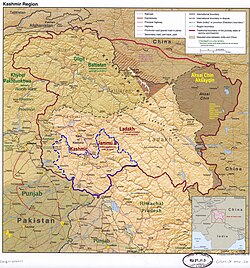Jammu district
District of Jammu and Kashmir administered by India From Wikipedia, the free encyclopedia
Jammu district is an administrative district of the Jammu division of Indian-administered Jammu and Kashmir in the disputed Kashmir region.[1] It is the most populous district in the Jammu division.[4]
Jammu district | |
|---|---|
 Bahu Fort, Jammu, India | |
 Interactive map of Jammu district | |
 Jammu district is in the Jammu division (shown with neon blue boundary) of Indian-administered Jammu and Kashmir (shaded in tan in the disputed Kashmir region[1] | |
| Coordinates (Jammu): 32.73°N 74.87°E | |
| Administering country | India |
| Union territory | Jammu and Kashmir |
| Division | Jammu Division |
| Headquarters | Jammu |
| Tehsils |
|
| Government | |
| • District Magistrate | Sachin Kumar Vaishya(IAS) |
| • Lok Sabha constituencies | Jammu (Lok Sabha constituency) |
| • Vidhan Sabha constituencies | 11 |
| Area | |
• Total | 2,342 km2 (904 sq mi) |
| • Urban | 252.13 km2 (97.35 sq mi) |
| • Rural | 2,089.87 km2 (806.90 sq mi) |
| Population (2011)[3] | |
• Total | 1,529,958 |
| • Density | 650/km2 (1,700/sq mi) |
| • Urban | 765,013 |
| • Rural | 764,945 |
| Demographics | |
| • Literacy | 83.45% |
| • Sex ratio | 880 |
| Time zone | UTC+05:30 (IST) |
| Vehicle registration | JK-02 |
| Website | http://jammu.nic.in/ |
Administrative divisions
Jammu District has 7 Sub-Divisions:
- Jammu South
- Jammu North
- R.S. Pura
- Marh
- Akhnoor
- Chowki Choura
- Khour
There are 21 tehsils:[5]
- Akhnoor
- Arnia
- Bahu
- Bhalwal
- Bishnah
- Chowki Choura
- Dansal
- Jammu
- Jammu North
- Jammu South
- Jammu West
- Jourian
- Kharah Balli
- Khour
- Maira Mandrian
- Mandal
- Marh
- Nagrota
- Pargwal
- Ranbir Singh Pura
- Suchetgarh
There are 20 Blocks:
- Akhnoor
- Arnia
- Bhalwal
- Bhalwal Brahmana
- Bishnah
- Chowki Choura
- Dansal
- Khour
- Kharah Balli
- Maira Mandrian
- Mandal
- Marh
- Mathwar
- Miran Sahib
- Nagrota
- Pargwal
- R.S. Pura
- Samwan
- Satwari
- Suchetgarh
Demographics
Summarize
Perspective
| Year | Pop. | ±% |
|---|---|---|
| 1901 | 291,399 | — |
| 1911 | 279,051 | −4.2% |
| 1921 | 285,361 | +2.3% |
| 1931 | 316,647 | +11.0% |
| 1941 | 364,253 | +15.0% |
| 1951 | 401,532 | +10.2% |
| 1961 | 438,810 | +9.3% |
| 1971 | 616,396 | +40.5% |
| 1981 | 792,490 | +28.6% |
| 1991 | 1,043,302 | +31.6% |
| 2001 | 1,357,077 | +30.1% |
| 2011 | 1,529,958 | +12.7% |
| † 1951 and 1991 populations are estimated Source: Census of India[6] | ||
According to the 2011 census Jammu district has a population of 1,526,406, roughly equal to the nation of Gabon[7] or the US state of Hawaii.[8] This gives it a ranking of 326th in India (out of a total of 640). The district has a population density of 596 inhabitants per square kilometre (1,540/sq mi) . Its population growth rate over the decade 2001-2011 was 12.48%. Jammu has a sex ratio of 871 females for every 1000 males, and a literacy rate of 83.98%.[citation needed] The Scheduled Castes and Scheduled Tribes account for 24.7% and 4.5% of the population of the district.[9]
| Jammu district: religion, gender ratio, and % urban of population, according to the 2011 Census.[3] | |||||||||
|---|---|---|---|---|---|---|---|---|---|
| Hindu | Muslim | Christian | Sikh | Buddhist | Jain | Other | Not stated | Total | |
| Total | 1,289,240 | 107,489 | 12,104 | 114,272 | 470 | 1,987 | 321 | 4,075 | 1,529,958 |
| 84.27% | 7.03% | 0.79% | 7.47% | 0.03% | 0.13% | 0.02% | 0.27% | 100.00% | |
| Male | 685,679 | 56,927 | 6,455 | 61,098 | 266 | 1,038 | 171 | 2,187 | 813,821 |
| Female | 603,561 | 50,562 | 5,649 | 53,174 | 204 | 949 | 150 | 1,888 | 716,137 |
| Gender ratio (% female) | 46.8% | 47.0% | 46.7% | 46.5% | 43.4% | 47.8% | 46.7% | 46.3% | 46.8% |
| Sex ratio (no. of females per 1,000 males) |
880 | 888 | 875 | 870 | – | 914 | – | 863 | 880 |
| Urban | 621,495 | 54,157 | 9,599 | 75,307 | 361 | 1,949 | 156 | 1,989 | 765,013 |
| Rural | 667,745 | 53,332 | 2,505 | 38,965 | 109 | 38 | 165 | 2,086 | 764,945 |
| % Urban | 48.2% | 50.4% | 79.3% | 65.9% | 76.8% | 98.1% | 48.6% | 48.8% | 50.0% |
| Sex Ratio in Jammu District in 2011 Census.[3] (no. females per 1,000 males) | ||||
|---|---|---|---|---|
| Religion (and population) | Sex Ratio | |||
| Hindu (pop 1,289,240) | 880 | |||
| Sikh (pop 114,272) | 870 | |||
| Muslim (pop 107,489) | 888 | |||
| Christian (pop 12,104) | 875 | |||
| Other (pop 2,778) | 883 | |||
| Not stated (pop 4,075) | 863 | |||
| Total (pop 1,529,958) | 880 | |||
Languages
The most widely spoken language of Jammu is Dogri. Other languages spoken are Punjabi, Urdu, Hindi, Kashmiri, Gojri and English.
References
External links
Wikiwand - on
Seamless Wikipedia browsing. On steroids.
